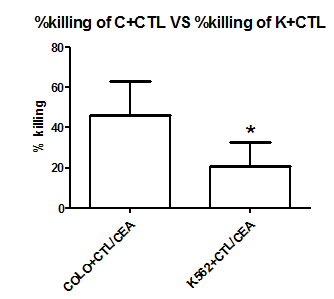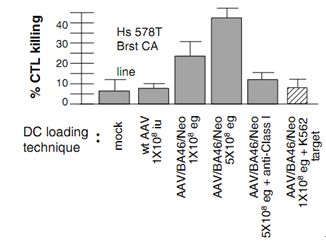Cytotoxic T lymphocyte (CTL), also known as killer T lymphocyte, is the main effector cell of normal human cellular immunity and one of the main effector cells of adoptive therapy for tumor immunity. It secretes various cytokines to participate in immunity. effect. It has a killing effect on certain viruses, tumor cells and other antigenic substances, and forms an important line of defense for the body's anti-virus and anti-tumor immunity with natural killer cells.
Function: Specific recognition of antigen peptide-MHC class I molecular complex, which can release perforin and particles through degranulation, and directly kill intracellular pathogens (viruses and some intracellular parasites) infected cells and tumor cells and other target cells.
Features: Antigen (Ag) specificity, MHC restriction, continuous killing.
Killing effect of CTL cells on target cells
Two mechanisms by which CTL kills target cells:
1. Granzyme pathway. The T cell receptor on the CTL interacts with the antigen presented on the surface of the target cell to form a polymer. The Golgi apparatus in the CTL began to accumulate, and the particles containing granzymes were relocated in the contact area with the target cells, and perforin and granzymes were released through exocytosis, the latter in the former Enter the target cell with the help of the cell, activate the apoptosis pathway of the cell, and induce the death of the cell.
2. The Fas approach. Some CTLs lack perforin and granzyme, which mediate cytotoxicity through the Fas pathway. The Fas ligand on the surface of CTL binds to Fas on the target cell, making it bind to Fas-associated death domain protein (FADD), which in turn triggers a series of reactions, leading to cell apoptosis.
At present, ACTL targeted cellular immunotherapy technology (“ACTL technology” for short) with independent intellectual property rights in China, which is induced by cytokines, transforms monocytes into dendritic cells with powerful antigen presentation function (Dendritic cells, DC), and the obtained DC can stimulate the production of cytotoxic T lymphocytes (Cytotoxic T lymphocytes, CTL) that effectively kill tumor cells. The generated CTL has tumor antigen specificity, that is, targeting. CTL stimulated by DCs infected with Recombinant Adeno-associated virus (rAAV) can only kill tumor cells that are positive for one or several tumor-associated antigens, but have no effect on antigen-negative cells.
Research on the Function of ACTL Technology CTL
Purpose:
(1) Observe the killing effect of CTL on COLO 205 cells;
(2) Observe the specificity (targeting) of CTL killing effect;
(3) Observe the restriction of MHC-I molecules (HLA-I antigens) for the killing effect of CTL.
Experiment 1: CTL killing effect experiment:
As shown in the figure above, the killing effect of CTL against COLO 205 cells is about 46.27%; the killing effect against K562 is 20.94%, and there is a significant difference between them. (*: P<0.05 vs COLO+CTL). It proves that CTL plays a killing effect against CEA antigen.
Experiment 2: Using artificially synthesized MHC-peptide tetramers, with the help of flow cytometry technology, quantitatively detect the number of antigen-specific T cells in the specimen to be tested.
PSA streaming results:
CEA streaming results:
The results of several tests showed that PSA-CTL accounted for 55.59% of the total number of cells tested, and CEA-CTL accounted for 47.33% of the total number of cells tested, proving the existence of specific CTLs.
Experiment 3: Adding MHC-I molecule antibody to block CTL killing tumor cells, using 51Cr cell killing experiment to confirm that the killing effect of CTL is MHC-I restricted.
The experimental results are as follows:
The experimental results confirmed that after the addition of MHC class I molecular antibodies, the ability of CTL activated by AAV/BA46 to kill tumor cells decreased, which proved that the killing ability of CTL was restricted to MHC class I.




